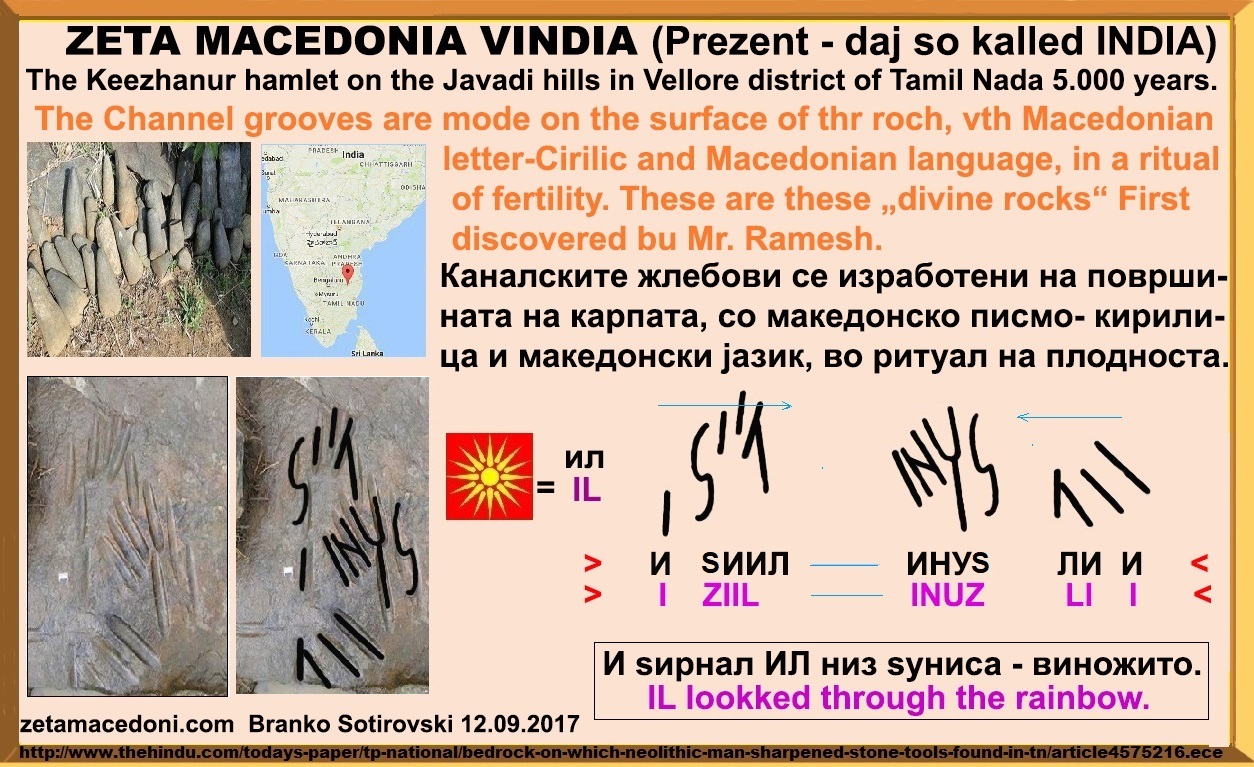12.09.2017
Zeta Macedonia Vindia (present-day
India)
A deity of LOOK-VEDI or VINDI
On the Javadhu Hills in the area
Vellore in Tamil Nadu, Mr. Ramesh found processed stones in a shape
of wedges.
Scientific team assumed they had been made around 5.000 years ago, “when people started to breeding agricultural crops”. According to my opinion, this processed
stones are older than is assumed. If we take into consideration the found artifacts,
which are 130.000 years old, in Patne, India, where is written “ZETA MACEDONIA
BY YOUR FATHER-IN-LAW. ILI I VO FROM UPRISING. WITH ILJO FATHER-IN-LAW” (Processed
in the book “Zeta Macedonia, 400.000 years of
literacy, Macedonian civilization on five continents, tradition up to now”, pg.
258). Or with the found artefact in Indonesia, on the island Java, which is
500.000 years old, where is written: “The engraving ligature, from right to
left reads: „АТ’З Л’С, СЛИ ИЅ НОДАМ“ < (“AT’Z L’S, SLI IDZ NODAM” <)
Transcribed into contemporary
Macedonian language it says: “MADON, MADONIA, MACEDONIA VIDENA E OD SVETLOSNIOT
ZRAK SAMO OD ZETOT“ (“MADON, MADONIA, MACEDONIA IS SEEN BY THE LIGHT RAY ONLY BY
THE ZET“) – the young sun from XXV December and XXII March.” (Extract from thebook “Zeta Macedonia, 500.000 years of literacy, Macedonian civilization onfive continents, tradition up to now”, digital edition, published on the sitezetamacedonia.com, pg. 16)
Macedonians as autochthon people on
the territory of present-day Asia since ever, since they became aware for
themselves and the environment, were breeding animals and agricultural crops.
They had own letter (Cyrillic and Latin), language (called SANSKRIT), faith in
mother Maria, Madona – ruler, Macedonia, Father Sun ILIJA and the son Macedon,
and culture of living. That is the period of the greatest globalizer of the world, the bride’s husband (ZET) – DON,
DION, DIONIS. Indonesia and India are heirs of that oldest, Macedonian culture
in the world.
People from the village Keezhallur, called
this conical stones as “sami kal”, and they considered them as a deity. They
used them for soil treatment and for cultivation of rice plantations. The
stones had been carved into a shape of sun ray and the sunny fertilizing GAZE
into the MUD. At the end of the workmanship of the wedges, which were used as a
plow, they sanctified them with a ritual on the shore of the holy river, which
flowed in that village. With the wedges, they wrote the holy message to
the God Sun, which means: From right to left reads: “INUDZ LI I <” and from
left to right reads: “I DZIIL…”. Transcribed into contemporary Macedonian
language it says: “AND IL LOOKED THORUGH THE RAINBOW”. The inscription has 21 grooves, which presents the 21-st of
December, the beginning of the new year and 21-st of March, the beginning of
spring. This tools are proof of the great scientific achievements and skills, arrived
from Macedonia, at least 500.000 years ago. Macedonians in that area made
revolution in science in the other tribal communities. Macedonian people with
their science, literacy and faith, on that territory, from the other tribal
communities, considered as deity, Lord on
the ground called LOOK-VEDI or VINDI).
The Javadhu Hills (also Jawadhi,
Jawadhu Hills) are an extension of the Eastern Ghats (discontinuous range of
mountains along India's eastern coast), spread across parts of Vellore and Tiruvannamalai
districts in the northern part of the state of Tamil Nadu in southeastern
India.This range separates Vellore and Tiruvannamalai districts. Vellore
district lies on the north western side and Tiruvannamalai district lies on the
south eastern side of this range.
According to the Indian “scientists”, “So-called
“centre” for sharpening polished Neolithic (stone) tools made about 5,000 years
ago has been found near the Keezhanur hamlet on the Javadi hills in Vellore
district of Tamil Nadu. Here are made 21 grooves, which the Neolithic man
sharpened the edges of his polished stone axes when they got blunted after
usage in cultivation. The shallow, trough-shaped grooves were formed by his
constantly sharpening the tools against the rock surface.
R. Ramesh, a field researcher under
the University Grants Commission-Special Assistance Programme, Department of
History, Pondicherry University, found these grooves on February 16 during
explorations on the Javadi hills, five km north of Pudur Nadu. This is the
first time that grooves used for sharpening stone axes have been found in Tamil
Nadu. They have been found at Sangnakallu-Kupagal in Bellary district,
Karnataka.

http://www.thehindu.com/todays-paper/tp-national/bedrock-on-which-neolithic-man-sharpened-stone-tools-found-in-tn/article4575216.ece